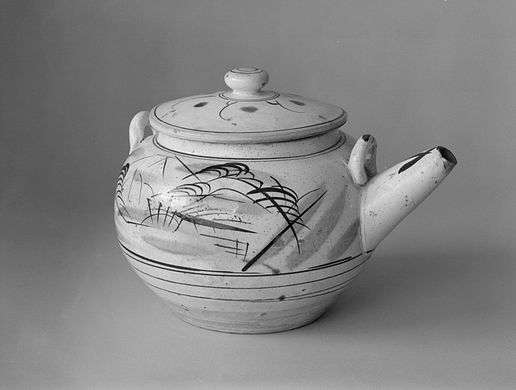Mingei
Mingei (民芸, "folk arts" or "arts of the people"), the Japanese folk art movement, was developed in the late 1920s and 1930s in Japan. Its founding father was Yanagi Sōetsu (1889–1961).
Origins
In 1916, Yanagi made his first trip to Korea out of a curiosity for Korean crafts. The trip led to the establishment of the Korean Folk Crafts Museum in 1924, and the coining of the term mingei by Yanagi, potters Hamada Shōji (1894–1978) and Kawai Kanjirō (1890–1966). In 1926, the Folk Art Movement was formally declared by Yanagi Sōetsu. Yanagi rescued lowly pots used by commoners in the Edo and Meiji period that were disappearing in rapidly urbanizing Japan. In 1936, the Japanese Folk Crafts Museum was established.
Theory
The philosophical pillar of mingei is "hand-crafted art of ordinary people" (民衆的な工芸 (minshū-teki-na kōgei)). Yanagi Sōetsu discovered beauty in everyday ordinary and utilitarian objects created by nameless and unknown craftsmen. According to Yanagi, utilitarian objects made by the common people are "beyond beauty and ugliness". Below are a few criteria of mingei art and crafts:
- made by anonymous crafts people
- produced by hand in quantity
- inexpensive
- used by the masses
- functional in daily life
- representative of the regions in which they were produced.
Yanagi's book The Unknown Craftsman has become an influential work since its first release in English in 1972. Yanagi's book examines the Japanese way of viewing and appreciating art and beauty in everyday crafts, including ceramics, lacquer, textiles, and woodwork.
Criticisms of Theory and Orientalism
In recent decades, scholars such as Yuko Kikuchi and Brian Moeran have claimed they have uncovered power relations and ultra-nationalism that lie at the core of the formation of mingei theory. In 1927, Yanagi put forward the "criterion of beauty in Japan" (日本における美の標準 nihon ni okeru bi no hyōjun) in The Way of Crafts (工芸の道 kōgei no michi). During the years of rising militarism in Japan, Sōetsu Yanagi extended his application of the "criterion of beauty" to the crafts of the Okinawans and the Ainu in the Japanese peripheries, and to those of the colonies including Korea, Taiwan and Manchuria. These scholars argue that mingei theory, far from being an Oriental theory, is a "hybridization" and "appropriation" of Occidental ideas such as that of William Morris (1834–1896)[1] which Bernard Leach (1887–1979) introduced when he lived and worked in Japan from 1909 to 1920.[2] Whereas Leach helped Japanese artists to rediscover their Oriental cultural origins in Occidental eyes, Japan applied Orientalism to its own art and projected the same Orientalism to the art of other Far Eastern countries such as Korea. Yūko Kikuchi terms this phenomenon "Oriental Orientalism".
Yanagi’s Korea and its Art was severely criticized by Korean intellectuals as a "colonialist view of history" in 1974. Yanagi defined "beauty of sadness" (悲哀の美 hiai no bi) as the "innate, original beauty created by the Korean race" (民族の固有の美 minzoku no koyū no bi). Yanagi believed that the long history of foreign invasions of Korea was reflected in Korean art, and especially in its pottery, in the "sad and lonely" lines. Such a theory has been criticized by Korean scholars as the "aesthetic of colonialism".
Examples of Mingei
 Leather Fireman's Coat, late 19th century. Brooklyn Museum
Leather Fireman's Coat, late 19th century. Brooklyn Museum%2C_ca._1950_Brooklyn_Museum.jpg) Inu-Hariko (Papier-mache Puppy Doll), ca. 1950. Brooklyn Museum
Inu-Hariko (Papier-mache Puppy Doll), ca. 1950. Brooklyn Museum_Brooklyn_Museum.jpg) Workman's Livery Coat (Happi), late 19th-early 20th century. Brooklyn Museum
Workman's Livery Coat (Happi), late 19th-early 20th century. Brooklyn Museum_Brooklyn_Museum.jpg) Futon-Gawa (Quilt Cover), early 20th century. Brooklyn Museum
Futon-Gawa (Quilt Cover), early 20th century. Brooklyn Museum Ko-Mashiko Ware Mado-e Dobin "Window Picture" Teapot, ca. 1915-35. Brooklyn Museum
Ko-Mashiko Ware Mado-e Dobin "Window Picture" Teapot, ca. 1915-35. Brooklyn Museum_Brooklyn_Museum.jpg) Oshi-e ("Push Picture"), A Geisha (Female Entertainer), 19th century. Brooklyn Museum
Oshi-e ("Push Picture"), A Geisha (Female Entertainer), 19th century. Brooklyn Museum
See also
References
- ↑ Wendy Jones Nakanishi, "The Anxiety of Influence: Ambivalent Relations Between Japan's 'Mingei' and Britain's 'Arts and Crafts' Movements", Electronic Journal of Japanese Studies, 28 October 2008
- ↑ Universal House of Justice (1986), "In Memoriam", The Bahá'í World, Bahá'í World Centre, XVIII: 929–31, ISBN 0-85398-234-1
Further reading
- Brandt, Kim. Kingdom of Beauty: Mingei and the Politics of Folk Art in Imperial Japan. Durham and London: Duke UP, 2007.
- Kikuchi, Yūko. Japanese Modernization and Mingei Theory: Cultural Nationalism and Oriental Orientalism. London and New York: RoutledgeCurzon, 2004.
- Saint-Gilles, Amaury. Mingei: Japan's Enduring Folk Arts. Union City, California: Heian International, 1983.
- Yanagi, Soetsu. The Unknown Craftsman: A Japanese Insight into Beauty. Tokyo, New York: Kodansha International, 1989.
- De Waal, Edmund. "Homo Orientals: Bernard Leach and the Image of the Japanese Craftsman". Journal of Design History, Vol. 10, No. 4, Craft, Culture and Identity (1997): 355–362.
- Karatani, Kojin and Kohso, Sabu. "Uses of Aesthetics: After Orientalism". Boundary 2, Vol. 25, No. 2, Edward Said (Summer, 1998): 145–160.
- Moeran, Brian. "Bernard Leach and the Japanese Folk Craft Movement: The Formative Years". Journal of Design History, Vol. 2, No. 2/3, (1989): 139–144.